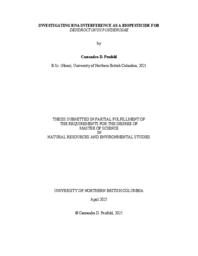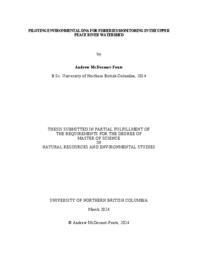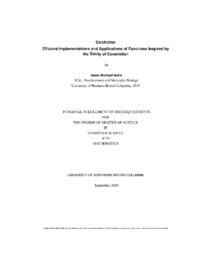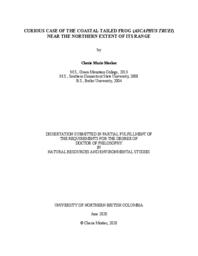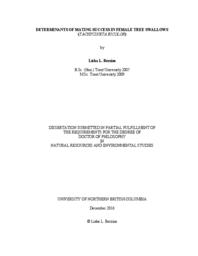Murray, Brent
Person Preferred Name
Brent Murray
Related Works
Content type
Digital Document
Origin Information
Content type
Digital Document
Origin Information
Content type
Digital Document
Description / Synopsis
Applications of environmental DNA (eDNA) represent one of the most significant recent advances in aquatic species monitoring. eDNA has the potential to dramatically increase the effectiveness and efficiency of fisheries monitoring across large geographic areas and particularly for species that have traditionally been difficult to survey. The Williston Reservoir and its surrounding watershed in northern British Columbia is a vast and heavily disturbed aquatic ecosystem where fish stocks have been difficult to monitor with traditional survey techniques. Although eDNA has many potential benefits, the validation process required in a novel environment can be a barrier to adoption. Primer choice and validation, study design and laboratory workflows are critical considerations for eDNA studies and must be evaluated when developing a novel approach in a particular geographic area. My research advanced the validation of species-specific eDNA assays for six prominent pelagic species in the Williston Reservoir and a generic, metabarcoding primer set that was effective in detecting the diversity of fish in the surrounding streams and rivers. The species-specific approach included the validation of four published assays and the development of novel assays for detecting lake trout (Salvelinus namaycush) and peamouth (Mylocheilus caurinus). Lake trout and bull trout (Salvelinus confluentus) are very closely related species that are sympatric throughout much of northwestern North America. The development of a novel lake trout assay that did not cross amplify bull trout eDNA is an important achievement for species-specific eDNA monitoring. Reservoir samples were collected from above and below the thermocline during the summer when the reservoir was stratified to identify species-specific patterns of eDNA distribution throughout the water column. Species detections in the reservoir were comparable for species-specific and metabarcoding assays when compared against gillnet catches in the reservoir. Abundant species that exhibit diel vertical migrations were detected by eDNA and gillnets at all depths. eDNA copy numbers detected were higher for samples with greater abundance and biomass of each species caught in the gillnets. Samples collected from tributaries around the reservoir were tested with metabarcoding primers and species detections were compared to results from a species-specific assay for Arctic grayling and a snorkel survey. Metabarcoding results were comparable to those from the Arctic grayling eDNA study and the snorkels survey, although the metabarcoding methods in this study were less sensitive due to a reduced amount of sample replication. Piloting eDNA in the Williston Reservoir and surrounding watershed has provided valuable insights into eDNA sampling design and the overall workflow for future eDNA studies in the region.
Origin Information
Content type
Digital Document
Description / Synopsis
Small molecules, including synthetic and those isolated from natural products, are important classes of compounds with broad utility, including drugs. The objectives of this dissertation were (i) to synthesize, purify, and characterize novel small molecule inhibitors on KRAS expression level; (ii) to purify and characterize antiproliferative small molecules from Onnia tomentosa and Sarcodon Scabripes. The first part of this Ph.D. dissertation focuses on synthesizing dispiropyrrolidizine derivatives with potential KRAS protein expression inhibitory activity. At the outset of this study, compound UNBC 152, which turned out to be a mixture of compounds, was found to possess bioactivities including antiproliferative activity and the ability to inhibit KRAS expression. This study aimed to synthesize UNBC 152 and resolve the compound-activity ambiguity. The investigation on UNBC 152 led to the isolation of two novel regioisomers, 6 and 7. Regioisomers 6 and 7 were synthesized using a one-pot three-component 1,3-dipolar cycloaddition reaction. They were purified using recrystallization method and their structures were determined by FTIR, ESI-LRMS, NMR, and X-ray crystallography. Regioisomers 6 and 7 showed the ability to inhibit KRAS protein expression. Over the past several decades, researchers have isolated many useful medicinal compounds from mushrooms. Medicinal mushrooms with validated anticancer properties in animals have been found and this has encouraged further exploration of fungal metabolites with antiproliferative activity. The second part of this Ph.D. dissertation focuses on isolating antiproliferative small molecules from two species of mushrooms native to British Columbia (BC). Chapters 3 and 4 described the use of antiproliferative activity-guided approach that led to the isolation and structural elucidation of small molecules from O. tomentosa and S. scabripes native to Northern BC. The ethanolic extracts of O. tomentosa and S. scabripes were purified using phase separation, Sephadex LH-20, and HPLC-based fractionation. The final structure of the small molecules was determined by ESI-LRMS, ESI-HRMS/MS, and NMR. Fatty acids (labeled 1.1-1.4 and 2-7) were identified from the ethanolic extract of O. tomentosa, while several p-terphenyl derivatives (1-4) and one phenolic aldehyde (5) were identified from S. scabripes. Amongst the small molecules, oleic acid (7), linoleic acid (6), and linoleic degradation products from O. tomentosa, and compounds 1-5 from S. scabripes showed antiproliferative activity against HeLa cervical cancer cells.
Origin Information
Content type
Digital Document
Description / Synopsis
Global ecosystems are increasingly affected by climate change leading to alterations in expected disturbance regimes. Outbreaks of irruptive insect pests represent some of the most destructive disturbance events possible that occur in the forests of North America. The mountain pine beetle, Dendroctonus ponderosae Hopkins (Coleoptera: Curculionidae) (MPB), an irruptive tree-killing pest of several species of pine, is responsible for the most damaging insect outbreak in recent history in western Canada, leading to a massive range expansion from established territory in British Columbia to pine stands in central and northern Alberta during the mid-2000s. The adaptive genetic structure of these new populations is relatively unknown a decade after range expansion and the selective response of the beetle to novel habitats is likewise understudied. There is increasing concern among forestry stakeholders that MPB may develop novel genetic traits or behaviours in response to their new habitat. In this study, I sampled beetle DNA and used double-digest restriction fragment genotyping-by-sequencing to generate single nucleotide polymorphism (SNP) loci. I used these data to investigate the establishment of genetic structure throughout the newly expanded and historic MPB range. I identified two distinct genetic clusters, a southern cluster for beetles located south of Banff National Park and a northern for beetles located north of the park. The data presented here suggest that Jasper National Park and the surrounding region represents an area of admixture between the two genetic clusters, caused in part by the movement of beetles from both the north and the south. This area of admixture may have the potential to differentiate into a separate third genetic cluster. Outlier analysis indicated that several landscape variables including mean annual precipitation and relative humidity contributed to the selective pressures on MPB, while frost free period contributes to the genotypes of beetles from the expanded range in central and northern Alberta. We also found that novel colonized MPB sites caused by in-flights from BC to Alberta did not display changes in genetic structure from their source population. Semivoltine MPB new adults collected from a site within the admixed zone near Jasper National Park displayed accumulation of cryoprotectants in response to cooling autumn temperatures but are not capable of surviving below -30℃. This is the first time that new adults have been demonstrated to cold harden, but also indicates that beetles from the admixed zone are likely not displaying aberrant forms of dispersal, host selection, or cold tolerance. I propose that beetles within the expanded range are not experiencing extreme selection events that would lead to genetic changes that will cause notable colonization, gustation, or dispersal differences to that of their counterparts in the historical range of BC. Warming climate is likely to contribute to beetle survival throughout central and northern Alberta, however, MBP populations will likely reach an endemic state and display historically expected population cycling (endemic to epidemic to endemic) in the future. The homogenous nature of MPB genetic structure throughout the expanded range does not support the development of populations-specific control techniques.
Origin Information
Content type
Digital Document
Description / Synopsis
Complexity poses a pervasive challenge in understanding formal and natural systems which can arise from a combination of a system's state and state transition rules. In situations in which many aspects of a system are changing together, it is desirable to quantify how much they do so. We motivate and define five mathematical functions that can be used to quantify coordinated changes in structure. We also developed ConAction, a Python package which implements these novel mathematical tools in a way that is performant, easy to install, and easy to use. These new tools can be applied to real research problems, which we exemplified by evaluating a classic isolation by distance model for Dendroctonus ponderosae populations in western North America
Origin Information
Content type
Digital Document
Description / Synopsis
Kokanee, the non-anadromous life history form of Oncorhynchus nerka, use lacustrine habitat in watersheds draining into the north Pacific Ocean. Kokanee have also been widely introduced into reservoirs following impoundment of rivers due to the construction of dams. Locally-adapted subpopulations of Kokanee, however, should be identified and evaluated when implementing watershed-level management strategies. In Chapter 1, I examined fork length, condition factor, and age at maturity for Kokanee in the Williston watershed of northern British Columbia to identify potential spatial and temporal trends in demographic structure following a large-scale stocking program that occurred in the 1990s. Adult spawning Kokanee that were native to the reservoir and collected prior to stocking events were significantly larger and maintained higher condition factors than Kokanee stocked from the Columbia River sampled in any year after 1991. Introduced Kokanee sampled in 2018 and 2019 were the smallest spawners and were significantly smaller than all fish collected between 1989 and 2018; the condition factors of these fish were also significantly lower than native Kokanee and the first spawning cohorts of Columbia-origin fish. The average age at maturity did not change across spatial or temporal scales (3 yrs.). My results indicate an ongoing trend of decreasing spawner size and condition factor for Kokanee in the Williston Reservoir since introduction events in the early 1990s. In Chapter 2, I analyzed the genetic population structure of Kokanee in the Williston watershed, including from the reservoir before stocking Columbia-origin fish and native populations from headwaters of the Williston Reservoir: Thutade, Arctic, and Tacheeda Lakes. Using microsatellite markers, I identified that all fish collected from 2006 to 2019 were introduced Columbia-origin genotypes, and there was no evidence of genetic divergence by spawning location. Native populations in Arctic and Tacheeda Lakes remained entirely separate from the reservoir populations, and there was no indication of past or current introgression with introduced stock. I identified that native Williston Reservoir Kokanee diverged from the Thutade Lake population; as native Williston fish have not been sampled since 2000, it is likely that this population has been extirpated in the reservoir by the successful Columbia-origin lineage. My results highlight an unfortunate consequence of underinformed management practices that failed to recognize the native Williston Kokanee as a distinct population. Strategies that incorporate knowledge of subpopulations of Williston watershed Kokanee, such as genetic populations or reproductive ecotypes, should be prioritized to conserve locally-adapted genetic diversity.
Origin Information
Content type
Digital Document
Description / Synopsis
Ascaphus truei, an ancient species of frog, migrated into British Columbia, Canada, following the last ice age. A. truei is of conservation interest because forestry practices, and the associated infrastructure, may reduce habitat quality. There is also concern that a warmer and drier climate will change the distribution and abundance of this species. I used two genetic methods, microsatellites and next-generation sequencing, to compare the genetic diversity of A. truei from the northern extent of its range in British Columbia, CA to southern Washington, USA. Both methods suggested a dramatic reduction in diversity across the northern portion of the species’ range. The phylogeography suggests a northern range expansion from a single refugium. I used DNA metabarcoding to compare the gut contents of larvae across three stream reaches and two development classes near the northern extent of A. truei's range. Gut contents differed between stream reach but did not differ among development class. Wetted width and ultimately stream volume may influence differences in gut content among stream reaches. I also quantified the relationship between an index of larvae density and environmental factors hypothesized to influence population density near the northern extent of the range. I assessed the segregation of larvae at various developmental stages. Wetted width and wetted depth correlated with differences in the abundance of larvae. Older developmental stages were captured in stream reaches with greater slopes than younger stages. Management should minimize modifications of stream structure, such as in-stream siltation due to road building. We should maintain habitat connectivity and gene flow to ensure the continued migration and adaptive capacity of A. truei.
Origin Information
Content type
Digital Document
Description / Synopsis
Understanding the mountain pine beetle detoxification systems is vital for predicting its continued spread into the novel jack pine host. Phylogenetic analyses were conducted for mountain pine beetle catalase, glutathione peroxidase, superoxide dismutase, and peroxiredoxin. These proteins were generally conserved, but there were differences in some key functional motifs. Specifically, a peroxiredoxin (DPPrx1) contained a unique combination of hyperoxidation motifs. DPPrx1 and a superoxide dismutase (DPSOD1) were selected for further functional analyses and demonstrated higher reactivity when compared to other SOD and Prx proteins. Also, DPPrx1 experiences hyperoxidation at a lower H2O2 concentration (~0.06 mM) than human peroxiredoxin (~0.12 mM). In other systems, hyperoxidized peroxiredoxin does act as a signal molecule for the expression of other oxidative stress proteins. Therefore, due to its relatively high reactivity and potential role as a cellular signal, DPPrx1 could serve as a future pest management target.
Origin Information
Content type
Digital Document
Description / Synopsis
The Chun T’Oh Wudujut is a provincial park located in the Interior Cedar-Hemlock biogeoclimatic zone. My objective was to assess the use of carabid beetles as bioindicators of change in this unique interior temperate rain forest ecosystem. Using a combination of morphotyping and DNA barcoding, I examined the diversity of carabid beetles in three different habitat types: clear-cuts, undisturbed old growth, and disturbed old growth subject to frequent human traffic. Nineteen species of carabid were observed, with the highest diversity occurring in clear-cut sites. Carabid diversity in both old growth habitats was similar, but differed from that in the clear-cuts. Temperature and relative humidity proved more variable in clear-cut sites; this may impact carabid biodiversity, and should be measured in future bioindicative studies. Several species of carabid beetles (alone and in combination) were identified as possible bioindicators, including Scaphinotus marginatus, Trechus chalybeus, Pterostichus herculaneus, and Pterostichus riparius.
Origin Information
Content type
Digital Document
Origin Information
Content type
Digital Document
Origin Information
Content type
Digital Document
Origin Information
Content type
Digital Document
Origin Information
Content type
Digital Document
Origin Information
Content type
Digital Document
Origin Information
Content type
Digital Document
Origin Information
Content type
Digital Document
Origin Information
Content type
Digital Document
Origin Information
Content type
Digital Document
Origin Information

